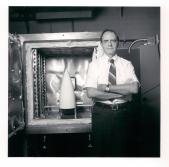The radomes developed at GTRI are used for intelligent missile systems, such as the Patriot. But in the late 1950s, Engineering Experiment Station (EES) scientists faced a challenge. How could radomes, the structures that shield a missile's sensors, withstand rapid high heating and harsh weather while maintaining a special quality that allows radio signals to pass through them?
Highly regarded for their work in high-temperature ceramic materials, EES researchers developed a slip-cast, fused-silica technique for forming refractories of massive size and complex shapes like radomes, missile nose cones, and rocket engine components. Over the years, they developed several improvements to the fused-silica process.
In 1970, researchers discovered that by manipulating the temperature, rate, and duration of heating, they could affect the development of the ceramic's mechanical strength in a phenomenon called sintering. The resulting material was 50% stronger than previous efforts yet maintained the necessary electromagnetic properties.
By the end of the 1980s, GTRI researchers learned that aluminoborosilicate fibers added strength. A further refinement was made when they found that short fiber lengths 20 or 30 times their diameter doubled radome strength with only a minimal loss of density.
The fibers increased the amount of energy needed to break the fused silica material. And should a crack develop, it would run into a fiber and follow the fiber along a tortuous path. The shorter fibers also prevented clumping, a condition that results in lower density and strength and large flaws during slip casting.

